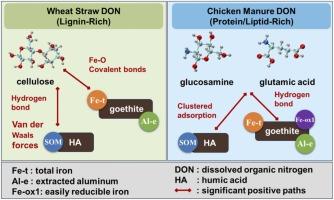Divergent Regulation of Dissolved Organic Nitrogen Release from Agricultural Wastes: Iron–Aluminum–Organic Carbon Interplay
IF 11.3
1区 环境科学与生态学
Q1 ENGINEERING, ENVIRONMENTAL
引用次数: 0
Abstract
The leaching of dissolved organic nitrogen (DON) from agricultural waste contributes to groundwater pollution, yet the regulatory soil factors and mechanisms—particularly those linked to DON source properties—remain poorly understood. We investogated the transport of wheat-straw-derived DON (WS-DON) and chicken-manure-derived DON (CM-DON) in representative regional Chinese soils using an integrated multiscale approach, including soil column experiments, convection–dispersion modeling, machine learning models (random forest with SHapley Additive exPlanations), partial least squares path modeling, and quantum chemical calculations. CM-DON exhibited 55.6% higher mobility than WS-DON. While total iron (Fe-t), exchangeable aluminum (Al-e), and total organic carbon (TOC) influenced both DON types, their regulatory roles differed. Fe-t (coefficient = 0.65) and TOC (0.42) enhanced WS-DON retention, with Al-e contributing indirectly via synergy with the Fe-TOC system. In contrast, CM-DON retention was mainly driven by the direct effects of Fe-t (0.69) and easily reducible Fe (Fe-ox1, 0.40), modulated by TOC–pH–Fe-ox1 indirect pathways. Quantum chemical analysis revealed that goethite retained hydroxyl-rich WS-DON via Fe–O stable covalent bonds (ΔE = −21.75 kcal mol−1), whereas CM-DON was weakly adsorbed through humic-acid-mediatd clustering. These results highlight the need for differentiated nutrient management strategies to mitigate DON leaching from agricultural residues.

农业废弃物中溶解有机氮释放的发散调控:铁-铝-有机碳的相互作用
农业废弃物中溶解有机氮(DON)的浸出导致地下水污染,然而土壤的调节因素和机制——特别是与DON来源特性相关的因素和机制——仍然知之甚少。采用综合多尺度方法,包括土柱实验、对流弥散模型、机器学习模型(SHapley加性解释随机森林)、偏最小二乘路径模型和量子化学计算,研究了小麦秸秆衍生DON (WS-DON)和鸡粪衍生DON (CM-DON)在中国代表性区域土壤中的迁移。CM-DON的迁移率比WS-DON高55.6%。虽然总铁(Fe-t)、交换性铝(Al-e)和总有机碳(TOC)对两种DON类型都有影响,但它们的调节作用不同。Fe-t(系数= 0.65)和TOC(0.42)增强WS-DON保留,Al-e通过与Fe-TOC系统的协同作用间接起作用。相比之下,CM-DON保留主要由Fe-t(0.69)和易还原性Fe (Fe-ox1, 0.40)的直接作用驱动,并由TOC-pH-Fe-ox1间接途径调节。量子化学分析表明,针铁矿通过Fe-O稳定共价键保留了富含羟基的WS-DON (ΔE = - 21.75 kcal mol - 1),而CM-DON则通过腐植酸催化的聚类被弱吸附。这些结果强调需要采取差异化的养分管理策略来减轻农业残留物的DON淋滤。
本文章由计算机程序翻译,如有差异,请以英文原文为准。
求助全文
约1分钟内获得全文
求助全文
来源期刊

Journal of Hazardous Materials
工程技术-工程:环境
CiteScore
25.40
自引率
5.90%
发文量
3059
审稿时长
58 days
期刊介绍:
The Journal of Hazardous Materials serves as a global platform for promoting cutting-edge research in the field of Environmental Science and Engineering. Our publication features a wide range of articles, including full-length research papers, review articles, and perspectives, with the aim of enhancing our understanding of the dangers and risks associated with various materials concerning public health and the environment. It is important to note that the term "environmental contaminants" refers specifically to substances that pose hazardous effects through contamination, while excluding those that do not have such impacts on the environment or human health. Moreover, we emphasize the distinction between wastes and hazardous materials in order to provide further clarity on the scope of the journal. We have a keen interest in exploring specific compounds and microbial agents that have adverse effects on the environment.
 求助内容:
求助内容: 应助结果提醒方式:
应助结果提醒方式:


